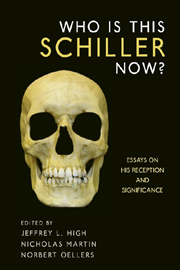Book contents
- Frontmatter
- Contents
- Foreword
- Acknowledgments
- List of Abbreviations
- Introduction: Why Is This Schiller [Still] in the United States?
- Part I Schiller, Drama, and Poetry
- Part II Schiller, Aesthetics, and Philosophy
- Part III Schiller, History, and Politics
- Part IV Schiller Reception — Reception and Schiller
- Part V Schiller Now
- Notes on the Contributors
- Index
Introduction: Why Is This Schiller [Still] in the United States?
Published online by Cambridge University Press: 05 February 2013
- Frontmatter
- Contents
- Foreword
- Acknowledgments
- List of Abbreviations
- Introduction: Why Is This Schiller [Still] in the United States?
- Part I Schiller, Drama, and Poetry
- Part II Schiller, Aesthetics, and Philosophy
- Part III Schiller, History, and Politics
- Part IV Schiller Reception — Reception and Schiller
- Part V Schiller Now
- Notes on the Contributors
- Index
Summary
THE INTERNATIONAL SCHILLER CONFERENCE, “Who is this Schiller [now]?” took place from Thursday 10 September through Saturday 12 September 2009 in the The Karl Anatol Center for Faculty Development at California State University Long Beach (CSULB). This volume comprises the revised and expanded papers of what was an unusually lively and productive conference on the occasion of the 250th anniversary of Friedrich Schiller's birth in 1759. The conference featured thirty-one papers in the course of three days. The average paper drew an audience of over eighty listeners, from a high of more than 120 listeners for a paper delivered in English on Thursday to a low of more than sixty-five listeners for a paper delivered in German on a Saturday — on a commuter campus. Although a substantial number of the audience members were academics from other universities in Southern California and from other programs and departments at CSULB, the largest group of audience members was made up of undergraduate and graduate students from CSULB, young people, educated in Southern California, and, once exposed to them, enthusiastic students of Schiller and his works. Why was “Who is this Schiller [now]?” held in the United States and why did a Schiller conference attract such an unusually large and dedicated audience? There are compelling reasons that have deep roots in US political and — to a lesser extent — immigration history; in the parallels between the moral-political philosophy of the founders of the United States and Schiller's own, and thus in US-American identity formation; and, subsequently, in US theater history and in the most resonant — and Schillerian — tropes of US-American art.
- Type
- Chapter
- Information
- Who Is This Schiller Now?Essays on his Reception and Significance, pp. 1 - 22Publisher: Boydell & BrewerPrint publication year: 2011

